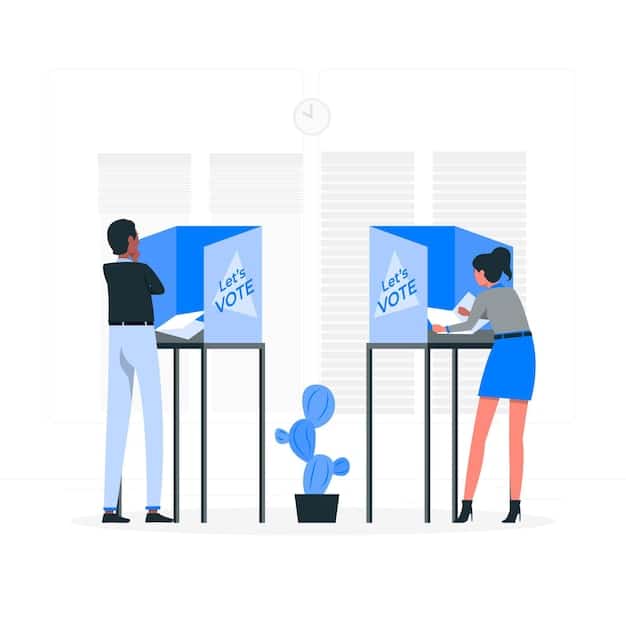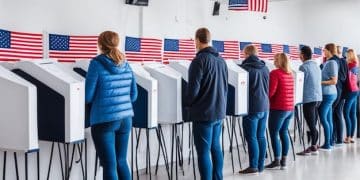The Impact of Social Media on the 2024 US Presidential Election

The Role of Social Media in Shaping Public Opinion: A Deep Dive into the 2024 Presidential Election reveals social media’s profound influence in disseminating news, influencing voter perceptions, and mobilizing support through targeted campaigns and viral content, thereby redefining political engagement and campaign strategies.
The role of social media in shaping public opinion: A deep dive into the 2024 presidential election has become undeniable. Social media platforms have transformed the landscape of political discourse and campaign strategies.
Understanding Social Media’s Influence on Political Opinion
Social media has become a dominant force in shaping public opinion, particularly during political campaigns. Understanding how these platforms operate is crucial for grasping their overall impact.
The Rise of Digital Political Discourse
The shift from traditional media to digital platforms has democratized information dissemination. Social media enables direct interaction between politicians and the public, bypassing traditional gatekeepers.
Understanding Algorithms and Echo Chambers
Algorithms on social media platforms personalize content based on user behavior, creating echo chambers. These echo chambers reinforce existing beliefs and limit exposure to diverse perspectives.
- Personalized content: Algorithms tailor content to individual preferences, reinforcing existing beliefs.
- Echo chambers: Users are primarily exposed to information that confirms their views, limiting diverse perspectives.
- Filter bubbles: The algorithmic isolation that prevents exposure to conflicting viewpoints, exacerbating polarization.
These algorithmic dynamics contribute to the deepening of political polarization. Users become entrenched in their views, making constructive dialogue challenging.

The 2024 Election: A Social Media Battleground
The 2024 election exemplified the intense battleground that social media has become for political campaigns. Various strategies were deployed to influence voter sentiment and behavior.
Campaign Strategies and Tactics
Campaigns leveraged social media to target specific demographics with tailored messages. The use of data analytics allowed for precise targeting based on demographics, interests, and online behavior.
The Spread of Misinformation and Disinformation
The rapid dissemination of misinformation and disinformation posed a significant challenge. Fake news and manipulated content spread rapidly, making it difficult for voters to discern truth from falsehood.
- Bots and trolls: Automated accounts that spread disinformation and create a false sense of popular support.
- Deepfakes: Realistic but fabricated videos used to distort information and damage reputations.
- Foreign interference: Organized efforts by foreign entities to influence the election outcome through social media manipulation.
Addressing the spread of misinformation requires a multi-faceted approach, including media literacy education and platform accountability.
Impact on Voter Turnout and Engagement
Social media has undeniably influenced voter turnout and engagement, offering both opportunities and challenges for democratic participation.
Mobilizing Voters Through Online Campaigns
Social media campaigns effectively mobilized voters, particularly among younger demographics. Online campaigns organized rallies, promoted voter registration, and encouraged participation on election day.
The Impact on Youth Engagement
Younger voters are increasingly engaged with politics through social media. These platforms provide accessible information and facilitate discussions on relevant issues.
- Direct interaction: Social media allows for direct communication between candidates and young voters.
- Inclusivity: Online platforms create inclusive spaces for political participation, especially for marginalized groups.
- Activism: Social media provides a platform for young activists to organize and advocate for their causes.
However, the digital divide remains a barrier to equitable participation. Efforts to bridge this gap are essential to ensure that all voices are heard.

The Role of Influencers and Celebrities
Influencers and celebrities played a key role in endorsing candidates and swaying public opinion during the 2024 election. Their endorsements can significantly impact voter choices.
Celebrity Endorsements and Their Reach
Celebrity endorsements generate attention and can mobilize specific voter segments. Their large followings provide a platform for disseminating campaign messages to a broad audience.
Ethical Considerations for Influencers
Ethical considerations arise when influencers promote political content. Transparency and disclosure are crucial to maintain credibility and avoid misleading their followers.
- Transparency: Clearly labeling sponsored political content to avoid deception.
- Objectivity: Providing unbiased information and avoiding misinformation.
- Responsibility: Being accountable for the impact of their endorsements on public opinion.
Regulation and oversight may be necessary to address ethical concerns and ensure fair practices within influencer marketing.
Analyzing Key Social Media Platforms
Different social media platforms played unique roles in the 2024 election. Analyzing each platform’s impact is crucial for understanding the overall digital landscape.
Facebook’s Role in Information Dissemination
Facebook remained a primary platform for news dissemination, but also faced challenges with misinformation. Its large user base makes it a powerful tool for political campaigns and social movements.
Twitter as a Space for Real-Time Political Commentary
Twitter served as a real-time platform for political commentary and breaking news. Its fast-paced environment facilitated quick reactions and discussions on unfolding events.
- Hashtag activism: Organizing and mobilizing support through trending hashtags.
- Direct engagement: Candidates use Twitter to directly engage with voters and address concerns.
- Rapid response: Disseminating information and responding to emerging issues quickly.
However, Twitter’s echo chamber effects and the prevalence of bots can amplify misinformation and polarization.
The Future of Social Media and Political Campaigns
The future of social media’s role in political campaigns is likely to evolve with technological advancements and changing user behavior. Understanding these trends is crucial.
Emerging Technologies and Their Potential Impact
AI, virtual reality, and augmented reality are emerging technologies that could transform political campaigns. These technologies offer new ways to engage voters and deliver personalized experiences.
The Need for Media Literacy Education
Media literacy education is essential to combat misinformation and promote informed decision-making. Equipping citizens with the skills to evaluate information critically is crucial for maintaining a healthy democracy.
- Critical thinking: Teaching individuals to analyze information objectively.
- Source evaluation: Identifying credible sources and recognizing potential biases.
- Fact-checking: Verifying information before sharing it to prevent the spread of misinformation.
Collaboration between educators, policymakers, and tech companies is needed to improve media literacy and ensure a well-informed electorate.
Conclusion
The role of social media in shaping public opinion: a deep dive into the 2024 presidential election underscores the necessity for continuous adaptation and awareness. As social media’s influence grows, understanding its dynamics and promoting responsible usage are vital for preserving the integrity of democratic processes.
| Key Point | Brief Description |
|---|---|
| 📱 Social Media’s Rise | Platforms became central in disseminating news and influencing voter perceptions. |
| 🎯 Targeted Campaigns | Campaigns use tailored messages to target specific voter demographics effectively. |
| 📣 Influencer Impact | Influencers play a key role in endorsing candidates and swaying public opinion. |
| 🛡️ Combating Misinformation | Media literacy education is essential to combat misinformation and promote informed decisions. |
Frequently Asked Questions
▼
Social media platforms served as primary channels for news dissemination, voter mobilization, and campaign messaging. They also played a role in shaping public perception through targeted advertising and viral content.
▼
Influencers endorsed candidates and swayed public opinion. Their endorsements can significantly impact voter choices, especially among younger demographics, by reaching a wider audience.
▼
Misinformation spread through fake news, bots, and manipulated content. These tactics made it difficult for voters to differentiate truth from falsehood, influencing voting decisions.
▼
Echo chambers and filter bubbles are environments where users are primarily exposed to information confirming existing beliefs, limiting diverse perspectives and reinforcing political polarization and divisions.
▼
Media literacy is essential to combat misinformation and promote informed decision-making. It equips citizens with the skills to analyze information critically, evaluate sources, and verify facts before sharing.
Conclusion
In summary, the 2024 presidential election demonstrated the profound influence of social media on public opinion and voter behavior. Understanding these dynamics is crucial for fostering a well-informed and engaged electorate, promoting responsible usage, and maintaining the integrity of democratic processes in the digital age.





